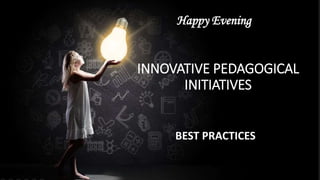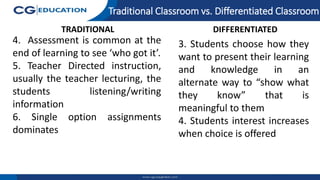Differentiated Instruction.pptx
- 2. Fiction
- 3. Reality
- 4. Animal School.mp4 How about │┘│¾Š▒▓§ŌĆ”
- 7. Differentiation refers to a wide variety of teaching techniques and lesson adaptations that educators use to instruct a diverse group of students, with diverse learning needs, in the same course, classroom, or learning environment.
- 9. Unfortunately, some classroom structures do not address this student diversity The biggest mistake of past centuries in teaching has been to treat all children as if they were variants of the same individual and thus to feel justified in teaching them all the same subjects in the same way. - Howard Gardener
- 10. A Survey Report Who manage to get just passing marks throughout the year, and year after year AVERAGE STUDENTS Students with better grasp of the subjects, high achievers ADVANCED LEARNERS Students who remain below average for their entire school life UNDER ACHIEVERS Good in some subjects, average in few and poor in one or two MIXED ABILITY LEARNERS A B C D
- 11. Effective Instructional Strategies 50 % 20 % 5 % 10 % 90 % 30 % 75 % Practice by doing Demonstration Teach others Audio Visual Discussion Reading Lecture
- 14. Without assistance, help and support, teachers canŌĆÖt develop a rationale for DI because first they require to unlearn orthodox patterns of instruction where they assume that all students need to learn the same information in the same way at the same time. To establish classrooms in which teachers can effectively address needs of academically diverse learners, it is necessary to go through intensive and sustained professional development. REALITY EXPECTATIONS Two roads diverged in a wood, and IŌĆö I took the one less traveled by, And that has made all the difference. - Robert Frost [The Road Not Taken] What is the challenge?
- 15. ŌĆ£ŌĆ” the question is not whether teachers recognize that such differences exist in virtually every classroom, or even whether they impact student success.ŌĆØ ŌĆ£The question that plagues teachers is HOW TO attend to the evident differences in a room that contains so many young bodies.ŌĆØ Rationale
- 16. What do I want my students to know, understand, and be able to do? What will I do instructionally to get my students to learn this? How will my students show what they know? The three most important questions a teacher must ask
- 17. If we only learn methods, we are tied to those methods, but if we learn principles, we can develop our own methods. ŌĆó A studentŌĆÖs current proximity to specified knowledge, understanding, and skills. Readiness ŌĆó That which engages the attention, curiosity, and involvement of a student. Interests ŌĆó A preference for taking in, exploring, or expressing content. Learning Profiles How do we influence studentsŌĆÖ learning?
- 18. The knowledge, understanding, and skills we want students to learn How students come to understand or make sense of the content. How students demonstrate what they have come to know, understand, and able to do after an extended period of learning How teachers measure what students have learned Content Process Product Assess- ment Modification required for Differentiated Instruction
- 19. Traditional Classroom vs. Differentiated Classroom 1. Instructions are given to help students engage and take responsibility in their learning 2. Learning Styles Considered (Multiple Intelligences) ŌĆó How students process learning ŌĆó How we prefer to acquire, process and remember information 1. Coverage of textbook and curriculum guides the instructions 2. All students working on the same task and expected to learn in the same manner 3. Information is typically presented in one way (orally, visually, written) ŌĆó No choice is provided to students in how they obtain the information TRADITIONAL DIFFERENTIATED
- 20. Traditional Classroom vs. Differentiated Classroom 3. Students choose how they want to present their learning and knowledge in an alternate way to ŌĆ£show what they knowŌĆØ that is meaningful to them 4. Students interest increases when choice is offered 4. Assessment is common at the end of learning to see ŌĆśwho got itŌĆÖ. 5. Teacher Directed instruction, usually the teacher lecturing, the students listening/writing information 6. Single option assignments dominates TRADITIONAL DIFFERENTIATED
- 21. LESSON PLANNING ’ā╝Make different & specific plans according to the studentŌĆÖs ability ’ā╝Use different teaching method for different group TEACHING MATERIALS ’ā╝ Audio/Visual tools ’ā╝ Categorized worksheets or assignments ’ā╝ Flash cards, graphic organizers ’ā╝ Bulletin boards, concept maps ’ā╝ Real life applications ASSESSMENT ’ā╝ Assessment for learning should be continuous ’ā╝ Same size fits all concept should be avoided ’ā╝ Assessment module should be planned before teaching the lesson Important practices a teacher must follow
- 22. RECAP - Differentiation of Instruction Is a teacherŌĆÖs response to learnerŌĆÖs needs Guided by general principles of differentiation Respectful tasks flexible grouping continuous assessment and adjustment Ways to differentiate Content Process Product According to studentsŌĆÖ Readiness interests Learning profile
- 23. 5 THINGS YOU MUST DO AS A LEADER DI is not a tool, or a method. itŌĆÖs a principle. So, more you discuss and prepare with your team, better the outcome will be. Regular re-enforcement is vital for its success. TRAIN YOUR FACULTY Revisit your planning and assessment system. Putting an old CPU in new casing cover wonŌĆÖt solve the problem. UPGRADE YOUR SYSTEM Nothing will change overnight! Everyone involved will have their doubts, and will struggle. Be strong and give strength to your team HAVE PATIENCE, BE CONSISTENT At the end of the day, it will be teacherŌĆÖs mindset that will be the game changer. Making your team realize and understand DI would be your biggest challenge TAKE YOUR FACULTY IN CONFIDENCE It will be difficult for some traditional teachers to change their ways. If you wish to bring a change, you should be prepared to replace people who have fixed mindset BE THE CHANGE, BE READY TO CHANGE
- 25. Thank You














![Without assistance, help and
support, teachers canŌĆÖt develop
a rationale for DI because first
they require to unlearn
orthodox patterns of instruction
where they assume that all
students need to learn the
same information in the same
way at the same time.
To establish classrooms in
which teachers can
effectively address needs of
academically diverse
learners, it is necessary to
go through intensive and
sustained professional
development.
REALITY
EXPECTATIONS
Two roads diverged in a wood, and IŌĆö
I took the one less traveled by,
And that has made all the difference.
- Robert Frost [The Road Not Taken]
What is the challenge?](https://image.slidesharecdn.com/differentiatedinstruction-230410013038-1d8dfea2/85/Differentiated-Instruction-pptx-14-320.jpg)










